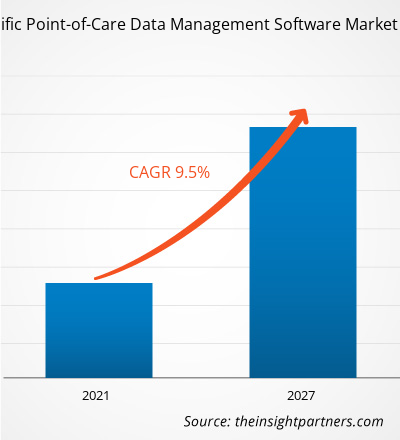The Asia Pacific point-of-care data management software market is expected to reach US$ 193.01 million by 2027 from US$ 102.28 million in 2020; it is estimated to grow at a CAGR of 9.5% from 2020 to 2027.
The growth of the market is attributed to increasing initiatives for the adoption of electronic health records, and rising incidence of infectious diseases and lifestyle-related diseases. However, the high cost of point-of-care data management systems hinders the market growth.
Point-of-care (POC) data management software is a platform used in various critical care settings in the hospital, such as intensive care unit (ICU), operating room (OR), and emergency department (ED). It facilitates the patients' health data management and analysis. Initiatives taken by various organizations to transform the healthcare infrastructure, such as the Health Information Technology for Economic and Clinical Health (HITECH) Act of 2009, are increasing the adoption of electronic health records (EHR) in healthcare facilities. Moreover, in 2015, the Centers for Medicare & Medicaid Services (CMS) and the Office of the National Coordinator for Health IT (ONC) supported the concept of electronic health records-meaningful use (EHR-MU). Meaningful use is attributed to ensure certified EHR technology, which provides the efficient electronic exchange of health information, thus improving the quality of care. Additionally, as healthcare data analytics is more commonly used to support patient-centred care and population health management, it is essential to have POCT results electronically integrated to include results tracking metrics and key performance indicators. Additionally, according to the Japanese Nursing Association survey, from September to October in 2019, around 63% of the hospitals in Japan implemented the system of EHR. The government in the country has been promoting the system's use since the beginning of the 2000s. Hence, rising government initiatives and rapid diagnosis of clinical conditions through point-of-care testing (POCT) support the growth of the market. Moreover, factors such as the increasing number of contagious diseases, rising incidence of lifestyle-related diseases (cardiac diseases and diabetes), growing demand for quick services, and surging technological advancements drive the need for POC data management software.
Countries in Asia Pacific are facing challenges due to increasing incidence of COVID-19. However, the outbreak has severely affected the medical devices and software industry and disrupted supply chain. Moreover, low-income countries face additional challenges due to the shortage of healthcare infrastructure. Restrictive measures have been put forth in South Korea, Malaysia, Singapore, the Philippines, and India to prevent disease transmission. However, in this scenario, patients receiving treatment for cancer, diabetic, or cardiology are not being treated on priority. Apart from overall health system, the point-of-care data management software market has been negatively impacted due to the outbreak.
- This FREE sample will include data analysis, ranging from market trends to estimates and forecasts.
ASIA PACIFIC POINT-OF-CARE DATA MANAGEMENT SOFTWARE MARKET SEGMENTATION
By Application
•
Glucose Monitoring• Hematology
• Cardiometabolic Monitoring
• Infectious Disease Devices
• Coagulation Monitoring
• Cancer Markers
• Urinalysis
• Others
By End User
- Hospitals/Critical Care Units
- Diagnostic Centers
- Clinics/Outpatient
By Country
- China
- Japan
- India
- Australia
- South Korea
- Rest of Asia Pacific
Company Profiles
- Abbott
- Siemens Healthineers AG
- F. HOFFMANN-LA ROCHE LTD.
- Randox Laboratories Ltd
- Radiometer Medical ApS
- THERMO FISHER SCIENTIFIC INC.
- Medical Information Technology, Inc.
Asia Pacific Point-of-Care Data Management Software Report Scope
| Report Attribute | Details |
|---|---|
| Market size in 2020 | US$ 102.28 Million |
| Market Size by 2027 | US$ 193.01 Million |
| Global CAGR (2020 - 2027) | 9.5% |
| Historical Data | 2018-2019 |
| Forecast period | 2021-2027 |
| Segments Covered |
By Application
|
| Regions and Countries Covered | Asia-Pacific
|
| Market leaders and key company profiles |
- Historical Analysis (2 Years), Base Year, Forecast (7 Years) with CAGR
- PEST and SWOT Analysis
- Market Size Value / Volume - Global, Regional, Country
- Industry and Competitive Landscape
- Excel Dataset


- Rugged Phones Market
- Asset Integrity Management Market
- Mobile Phone Insurance Market
- Long Read Sequencing Market
- Malaria Treatment Market
- Biopharmaceutical Contract Manufacturing Market
- Adaptive Traffic Control System Market
- Airline Ancillary Services Market
- Green Hydrogen Market
- Truck Refrigeration Market

Report Coverage
Revenue forecast, Company Analysis, Industry landscape, Growth factors, and Trends

Segment Covered
Application and End User

Regional Scope
North America, Europe, Asia Pacific, Middle East & Africa, South & Central America

Country Scope
Australia, China, Japan, South Korea
Trends and growth analysis reports related to Technology, Media and Telecommunications : READ MORE..
- Abbott
- Siemens Healthineers AG
- F. HOFFMANN-LA ROCHE LTD.
- Randox Laboratories Ltd
- Radiometer Medical ApS
- THERMO FISHER SCIENTIFIC INC.
- Medical Information Technology, Inc.

 Get Free Sample For
Get Free Sample For